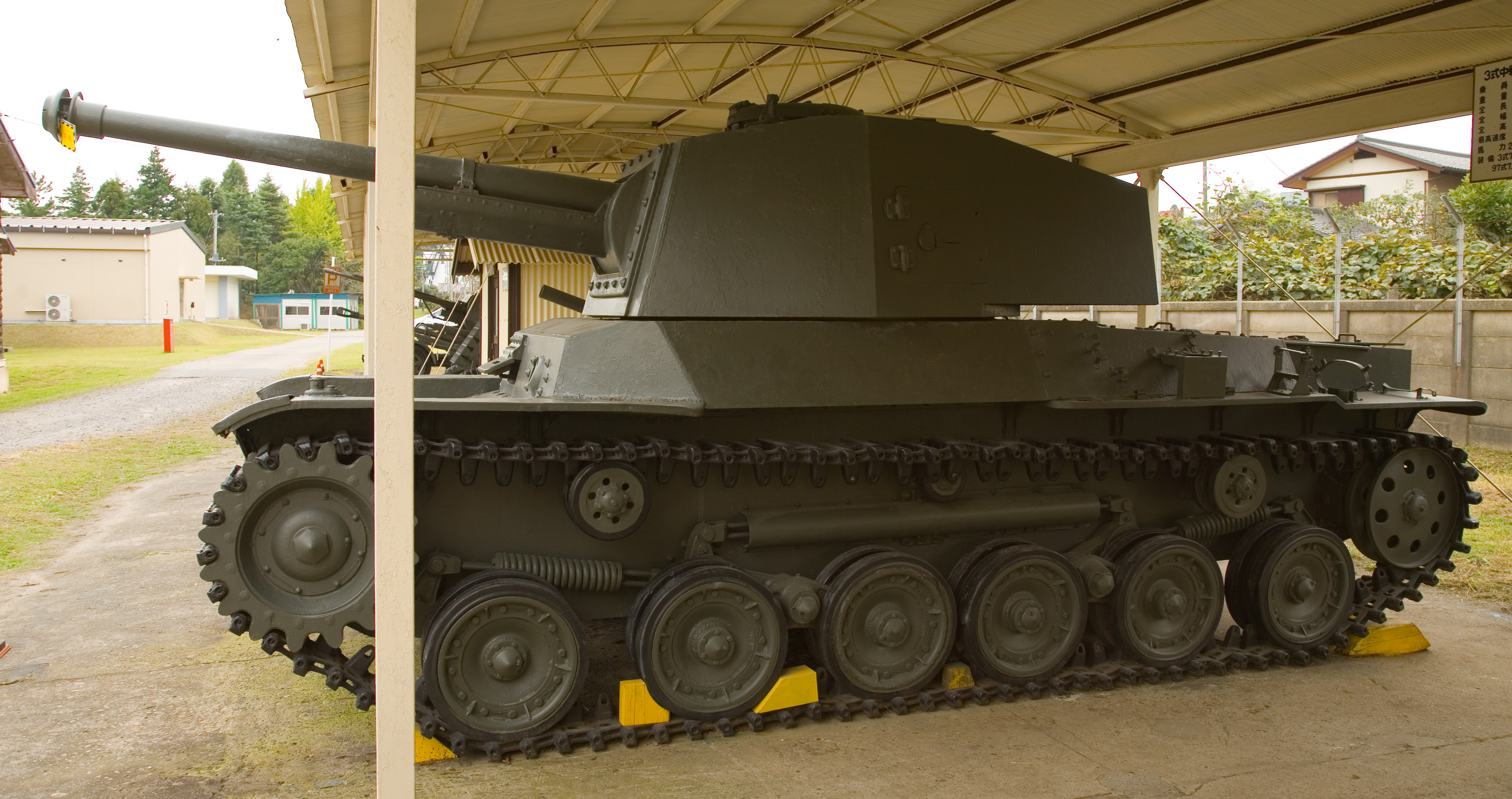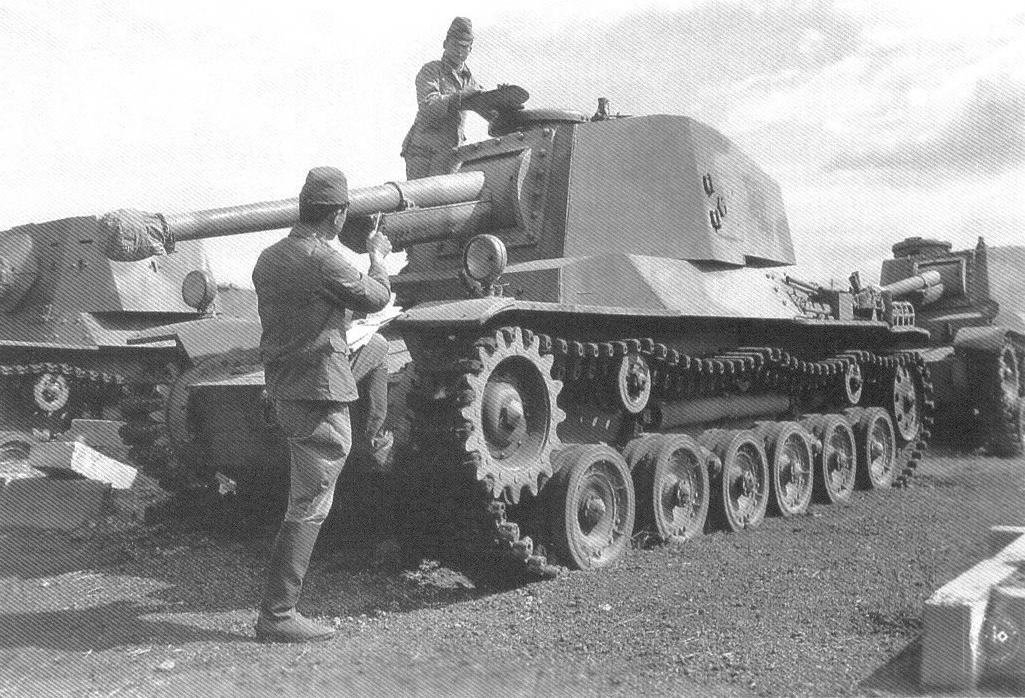Type 3 Chi-Nu on:
[Wikipedia]
[Google]
[Amazon]
was a 
Retrieved 2 May 2016. Development of the Type 3 Chi-Nu occurred in 1943. The low priority given to tank production meant that the Type 3 did not actually enter production until 1944, by which time raw materials were in very short supply, and in 1945 much of Japan's industrial infrastructure had been destroyed by American strategic bombing. This led to its production run being severely curtailed. Only a total of between 144 and 166 units were produced. The Type 3 Chi-Nu was the last tank that was fielded by the Imperial Japanese armed forces, and was still in production at the end of the war.

Taki's Imperial Japanese Army: Type 1 "Chi-He"
/ref>

 The Type 3 Chi-Nu was allocated to the
The Type 3 Chi-Nu was allocated to the
Taki's Imperial Japanese Army Page - Akira Takizawa
{{WWIIJapaneseAFVs
medium tank
A medium tank is a classification of tanks, particularly prevalent during World War II, which represented a compromise between the mobility oriented light tanks and the armour and armament oriented heavy tanks. A medium tank's classification ...
of the Imperial Japanese Army
The Imperial Japanese Army (IJA; , ''Dai-Nippon Teikoku Rikugun'', "Army of the Greater Japanese Empire") was the principal ground force of the Empire of Japan from 1871 to 1945. It played a central role in Japan’s rapid modernization during th ...
in World War II
World War II or the Second World War (1 September 1939 – 2 September 1945) was a World war, global conflict between two coalitions: the Allies of World War II, Allies and the Axis powers. World War II by country, Nearly all of the wo ...
. Like the Type 1 Chi-He, this tank was an improved version of the Type 97 Chi-Ha. It incorporated a Type 3 75 mm tank gun, one of the largest Japanese tank guns during the war.
The Chi-Nu did not see combat during the war. All produced units were retained for the defense of the Japanese Homeland in anticipation of an Allied invasion.

History and development
At the outbreak of thePacific War
The Pacific War, sometimes called the Asia–Pacific War or the Pacific Theatre, was the Theater (warfare), theatre of World War II fought between the Empire of Japan and the Allies of World War II, Allies in East Asia, East and Southeast As ...
, the Type 97 Chi-Ha medium tank and Type 95 Ha-Go light tank designs comprised the mainstay of the armored units of the Imperial Japanese Army
The Imperial Japanese Army (IJA; , ''Dai-Nippon Teikoku Rikugun'', "Army of the Greater Japanese Empire") was the principal ground force of the Empire of Japan from 1871 to 1945. It played a central role in Japan’s rapid modernization during th ...
. As the war progressed, these tanks started to face significant challenges posed by Allied tanks. In the Burma
Myanmar, officially the Republic of the Union of Myanmar; and also referred to as Burma (the official English name until 1989), is a country in northwest Southeast Asia. It is the largest country by area in Mainland Southeast Asia and ha ...
and Philippines Campaigns, the firepower of the 57 mm cannon mounted on the Type 97 was proven to be insufficient against Allied tanks. The Imperial Japanese Army therefore developed the Type 1 47 mm tank gun, which used a lighter high-explosive round with greater armor penetrating power. This gun was mounted on Type 97 Shinhoto Chi-Ha and Type 1 Chi-He medium tanks.
At the later stages of the war, large numbers of American M4 Sherman
The M4 Sherman, officially medium tank, M4, was the medium tank most widely used by the United States and Western Allies in World War II. The M4 Sherman proved to be reliable, relatively cheap to produce, and available in great numbers. I ...
tanks arrived at the front line and increased pressure on Japanese armored forces. The decided to develop a new medium tank to counter the enemy threat as well as a replacement for the Type 97.
The Army Technical Bureau had been working on the Type 4 Chi-To medium tank as the counter to the M4 Sherman, but there were problems and delays in the program. As a result, a stopgap tank was required. The Type 3 medium tank Chi-Nu was developed to cope with the M4 Sherman.Taki's Imperial Japanese Army: "Tanks after Chi-Ha"Retrieved 2 May 2016. Development of the Type 3 Chi-Nu occurred in 1943. The low priority given to tank production meant that the Type 3 did not actually enter production until 1944, by which time raw materials were in very short supply, and in 1945 much of Japan's industrial infrastructure had been destroyed by American strategic bombing. This led to its production run being severely curtailed. Only a total of between 144 and 166 units were produced. The Type 3 Chi-Nu was the last tank that was fielded by the Imperial Japanese armed forces, and was still in production at the end of the war.

Design
Armor and protection
The Type 3 Chi-Nu retained the same chassis and suspension of the Type 1 Chi-He, but with the addition of an enlarged turret ring for the new large hexagonalgun turret
A gun turret (or simply turret) is a mounting platform from which weapons can be fired that affords protection, visibility and ability to turn and aim. A modern gun turret is generally a rotatable weapon mount that houses the crew or mechanis ...
with a commander's cupola. It was the last design based directly on Type 97 lineage. The thickest armor used was 50 mm on the front hull; it also had 25 mm on the turret, 25 mm on the sides and 20 mm on the rear deck.

Armament
The main armament of the Type 3 Chi-Nu was the 75 mm Type 3 tank gun. The gun could be elevated between -10 and +25 degrees. Firing a shell at amuzzle velocity
Muzzle velocity is the speed of a projectile (bullet, pellet, slug, ball/ shots or shell) with respect to the muzzle at the moment it leaves the end of a gun's barrel (i.e. the muzzle). Firearm muzzle velocities range from approximately t ...
of it gave an armor penetration of at and at . Secondary armament was a 7.7 mm Type 97 machine gun.
Mobility
The Chi-Nu had the same engine as the Type 1 Chi-He, producing 240 hp and a top speed of 39 km/h./ref>
Service record

Japanese home islands
The is an archipelago of 14,125 islands that form the country of Japan. It extends over from the Sea of Okhotsk in the northeast to the East China and Philippine seas in the southwest along the Pacific coast of the Eurasian continent, and cons ...
to defend against the projected Allied Invasion. They were to be part of the "Mobile Shock Force" to be used for counter-attacks against the Allied invasion. As the surrender of Japan
The surrender of the Empire of Japan in World War II was Hirohito surrender broadcast, announced by Emperor Hirohito on 15 August and formally Japanese Instrument of Surrender, signed on 2 September 1945, End of World War II in Asia, ending ...
occurred before that invasion, the Type 3 was never used in combat operations. The 4th Tank Division based in Fukuoka
is the List of Japanese cities by population, sixth-largest city in Japan and the capital city of Fukuoka Prefecture, Japan. The city is built along the shores of Hakata Bay, and has been a center of international commerce since ancient times. ...
on Kyushu
is the third-largest island of Japan's Japanese archipelago, four main islands and the most southerly of the four largest islands (i.e. excluding Okinawa Island, Okinawa and the other Ryukyu Islands, Ryukyu (''Nansei'') Ryukyu Islands, Islands ...
had a "significant" number of the Type 3 Chi-Nu tanks produced at its depot by the end of the war.
Survivor
One surviving Type 3 medium tank is on display at theJapan Ground Self-Defense Force
The , , also referred to as the Japanese Army, is the land warfare branch of the Japan Self-Defense Forces. Created on July 1, 1954, it is the largest of the three service branches.
New military guidelines, announced in December 2010, direct ...
Military Ordnance Training School at Tsuchiura, Ibaraki, Japan
Japan is an island country in East Asia. Located in the Pacific Ocean off the northeast coast of the Asia, Asian mainland, it is bordered on the west by the Sea of Japan and extends from the Sea of Okhotsk in the north to the East China Sea ...
.
Variant
*Type 3 Chi-Nu Kai prototype/Chi-Nu II :A "modification plan" for the Chi-Nu was for it to be up gunned with the Type 5 75 mm tank gun (L/56.4) and a Type 4 Chi-To turret. The exact status on the progress of the Chi-Nu Kai prototype is unknown.See also
Japanese tanks of World War IITanks of comparable role, performance, and era
* Argentine Nahuel DL 43 * AustralianSentinel
Sentinel may refer to:
Places Mountains
* Mount Sentinel, a mountain next to the University of Montana in Missoula, Montana
* Sentinel Buttress, a volcanic crag on James Ross Island, Antarctica
* Sentinel Dome, a naturally occurring granit ...
* British Cromwell
* Canadian Ram II
* German Panzer IV
The IV (Pz.Kpfw. IV), commonly known as the Panzer IV, is a German medium tank developed in the late 1930s and used extensively during the Second World War. Its ordnance inventory designation was Sd.Kfz. 161.
The Panzer IV was the most numer ...
* Hungarian Turán III
* Italian Carro Armato P 40
* Italian P43 (proposal)
* Romanian 1942 medium tank (proposal)
* Soviet T-34
The T-34 is a Soviet medium tank from World War II. When introduced, its 76.2 mm (3 in) tank gun was more powerful than many of its contemporaries, and its 60-degree sloped armour provided good protection against Anti-tank warfare, ...
* United States M4 Sherman
The M4 Sherman, officially medium tank, M4, was the medium tank most widely used by the United States and Western Allies in World War II. The M4 Sherman proved to be reliable, relatively cheap to produce, and available in great numbers. I ...
Notes
References
* * * * * *External links
Taki's Imperial Japanese Army Page - Akira Takizawa
{{WWIIJapaneseAFVs
Type 3 Chi-Nu
was a medium tank of the Imperial Japanese Army in World War II. Like the Type 1 Chi-He, this tank was an improved version of the Type 97 Chi-Ha. It incorporated a Type 3 75 mm tank gun, one of the largest Japanese tank guns during the war.
The ...
3 Chi-Nu
World War II medium tanks
Mitsubishi
Military vehicles introduced from 1940 to 1944